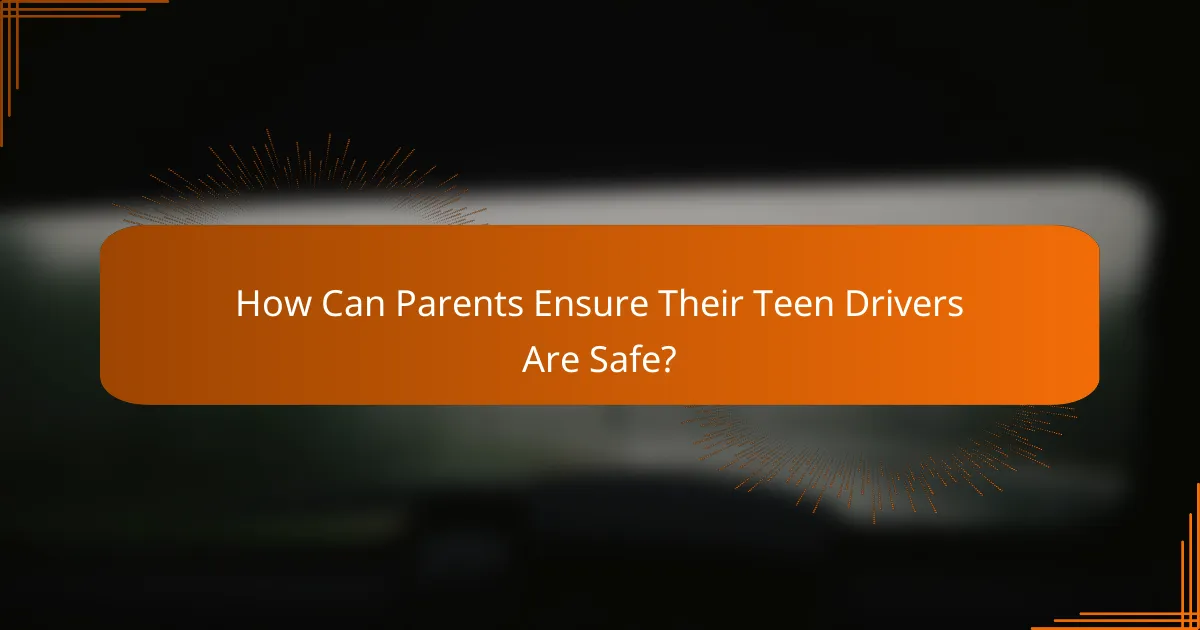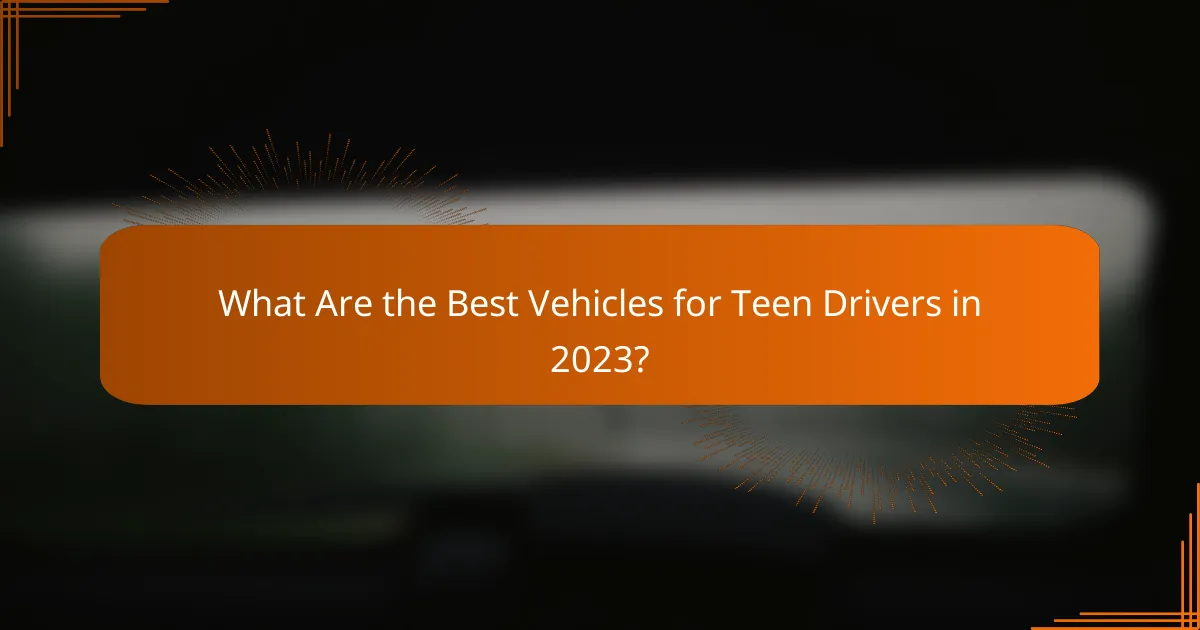As teen drivers embark on their journey behind the wheel, essential safety tech upgrades play a crucial role in enhancing vehicle control and minimizing accident risks. By integrating advanced safety features, parents can help create a supportive driving environment that fosters responsible habits and confidence on the road.

What Are the Essential Safety Features for Teen Drivers?
Essential safety features for teen drivers include technologies designed to enhance vehicle control and reduce the risk of accidents. These features help inexperienced drivers navigate the roads more safely, making driving a less daunting experience.
Automatic Emergency Braking
Automatic Emergency Braking (AEB) detects potential collisions and applies the brakes if the driver does not react in time. This feature is particularly beneficial for teen drivers who may be prone to distractions or misjudgments. AEB can significantly reduce the severity of accidents or even prevent them altogether.
When considering AEB, look for systems that can detect both vehicles and pedestrians. Some models may offer additional features, such as forward collision warning, which alerts the driver before braking is necessary.
Lane Departure Warning
Lane Departure Warning (LDW) alerts drivers when they unintentionally drift out of their lane without signaling. This feature is crucial for teen drivers who may still be developing their lane-keeping skills. LDW typically uses cameras to monitor lane markings and provides visual or audible warnings.
For added safety, consider vehicles that include Lane Keeping Assist, which can automatically steer the car back into the lane if the driver does not respond to the warning. This can be particularly helpful on long drives or during periods of fatigue.
Adaptive Cruise Control
Adaptive Cruise Control (ACC) automatically adjusts the vehicle’s speed to maintain a safe following distance from the car ahead. This feature is especially useful for teen drivers who may struggle with speed management in varying traffic conditions. ACC can help reduce stress during highway driving.
When evaluating ACC systems, check if they can handle stop-and-go traffic, as some models can bring the car to a complete stop and resume speed automatically. This can enhance safety in congested areas.
Blind Spot Monitoring
Blind Spot Monitoring (BSM) alerts drivers to vehicles in their blind spots, which is crucial for safe lane changes. Teen drivers often lack experience in checking blind spots, making BSM an essential feature. The system typically uses sensors to detect vehicles and provides visual or audible alerts.
Look for BSM systems that include rear cross-traffic alerts, which can assist when reversing out of parking spaces. This added layer of safety can help prevent accidents in crowded areas.
Traction Control Systems
Traction Control Systems (TCS) help prevent wheel spin during acceleration, particularly on slippery surfaces. This feature is vital for teen drivers who may not yet have experience driving in adverse weather conditions. TCS works by adjusting engine power or applying brakes to individual wheels to maintain traction.
When considering TCS, ensure it is integrated with the vehicle’s stability control system for enhanced safety. This combination can significantly improve handling and stability, especially in challenging driving scenarios like rain or snow.

How Can Parents Ensure Their Teen Drivers Are Safe?
Parents can ensure their teen drivers are safe by establishing clear guidelines, utilizing technology, and maintaining open communication. These strategies help create a supportive environment that encourages responsible driving habits.
Implementing a Parent-Teen Driving Agreement
A Parent-Teen Driving Agreement sets expectations and responsibilities for both parties. This document should outline rules regarding driving times, passenger limits, and consequences for violations.
Consider including a checklist of safe driving practices, such as avoiding distractions and obeying speed limits. Regularly reviewing this agreement can reinforce its importance and adapt it as the teen gains experience.
Utilizing GPS Tracking Apps
GPS tracking apps can provide real-time location updates and driving behavior insights. These tools help parents monitor their teen’s driving habits, such as speed and hard braking, which can indicate risky behavior.
Many apps offer features like geofencing, which alerts parents when their teen leaves a designated area. Choose an app that balances safety monitoring with respect for privacy, ensuring it fosters trust rather than surveillance.
Setting Up Regular Check-Ins
Regular check-ins between parents and teen drivers are crucial for ongoing communication about driving experiences. These discussions can help address any concerns and reinforce safe driving practices.
Establish a routine, such as weekly conversations or monthly driving assessments, to discuss challenges and successes. This approach not only supports safety but also strengthens the parent-teen relationship through shared experiences.

What Are the Best Vehicles for Teen Drivers in 2023?
In 2023, the best vehicles for teen drivers prioritize safety, reliability, and affordability. Models like the Honda Civic, Toyota Corolla, Subaru Impreza, and Ford Mustang stand out for their combination of essential safety features and user-friendly characteristics.
Honda Civic
The Honda Civic is a top choice for teen drivers due to its strong safety ratings and advanced driver-assistance features. It includes standard safety technologies like collision mitigation braking and lane-keeping assist, which help new drivers stay safe on the road.
Additionally, the Civic is known for its fuel efficiency, making it a cost-effective option for families. Its spacious interior and reliable performance further enhance its appeal for young drivers.
Toyota Corolla
The Toyota Corolla is another excellent vehicle for teens, offering a reputation for reliability and longevity. With its standard Toyota Safety Sense suite, it provides features such as adaptive cruise control and automatic high beams, which are beneficial for inexperienced drivers.
Moreover, the Corolla’s compact size makes it easy to maneuver in urban settings, while its affordability in both purchase price and maintenance costs makes it a practical choice for families.
Subaru Impreza
The Subaru Impreza is well-regarded for its all-wheel drive, providing enhanced traction and stability, especially in adverse weather conditions. This feature is particularly valuable for teen drivers who may face varying road conditions.
Safety is a priority with the Impreza, as it comes equipped with advanced safety features like EyeSight Driver Assist Technology. Its spacious interior and comfortable ride make it a practical option for young drivers and their passengers.
Ford Mustang
For teens looking for a sporty option, the Ford Mustang offers an exciting driving experience without compromising on safety. While it is a performance vehicle, it includes modern safety features such as rearview cameras and advanced airbag systems.
However, parents should consider the Mustang’s higher insurance costs and fuel consumption compared to other vehicles on this list. Balancing performance with practicality is key when selecting this model for a teen driver.

What Are the Costs of Safety Tech Upgrades?
The costs of safety tech upgrades for vehicles can vary widely based on the features selected and the vehicle model. Generally, these upgrades can range from a few hundred to several thousand dollars, depending on the complexity and technology involved.
Estimated Costs for Safety Features
Safety features such as automatic emergency braking, lane departure warning, and adaptive cruise control typically range from $300 to $3,000. Higher-end systems, like collision avoidance and advanced driver-assistance systems (ADAS), can cost between $1,000 and $5,000 or more. Consider the long-term benefits of these upgrades, including potential reductions in accident-related costs.
When evaluating costs, factor in installation fees if the features are not factory-installed. Some dealerships may offer package deals that can lower the overall expense, so it’s worth inquiring about bundled options.
Insurance Discounts for Safety Tech
Many insurance companies offer discounts for vehicles equipped with advanced safety technologies. These discounts can range from 5% to 30%, depending on the insurer and the specific features installed. For instance, vehicles with anti-lock brakes or electronic stability control may qualify for lower premiums.
To maximize potential savings, inform your insurance provider about any safety upgrades made to your vehicle. It’s advisable to shop around and compare quotes from different insurers, as some may provide better discounts for specific safety technologies.

How Do Safety Features Impact Insurance Rates?
Safety features can significantly lower insurance rates for teen drivers by reducing the risk of accidents. Insurers often offer discounts for vehicles equipped with advanced safety technologies, which can lead to substantial savings over time.
Discounts for Advanced Safety Features
Many insurance companies provide discounts for vehicles that include advanced safety features such as automatic emergency braking, lane departure warning, and adaptive cruise control. These features are designed to prevent accidents, making the insured vehicle less of a risk. Discounts can range from 5% to 30%, depending on the insurer and the specific features included.
When shopping for insurance, it’s beneficial to inquire about available discounts for safety technologies. Some insurers may even have specific programs that reward drivers with safer vehicles, so be sure to compare options to maximize savings.
Comparative Analysis of Insurance Rates
Insurance rates can vary significantly based on the safety features of a vehicle. For instance, a car equipped with multiple safety technologies may have a lower premium compared to a similar model without these features. This is because insurers assess the likelihood of claims based on the vehicle’s safety profile.
To make an informed decision, consider obtaining quotes from multiple insurance providers. Look for differences in premiums related to safety features and evaluate the overall value of the coverage offered. This approach will help ensure that you select the best policy for your needs while taking advantage of potential savings.

What Are the Latest Trends in Teen Driver Safety Technology?
Recent advancements in teen driver safety technology focus on integrating innovative features that enhance vehicle safety and promote responsible driving habits. These technologies aim to reduce accidents and improve overall road safety for young drivers.
Integration of AI in Safety Features
Artificial Intelligence (AI) is increasingly being integrated into safety features designed for teen drivers. This technology can analyze driving behavior in real-time, providing feedback and alerts to help young drivers improve their skills and avoid risky situations.
For example, AI systems can monitor speed, braking patterns, and even distractions caused by mobile devices. If a teen driver exceeds speed limits or shows signs of inattention, the system can send alerts to both the driver and their guardians, fostering accountability.
When considering AI safety features, parents should look for systems that offer customizable settings, allowing them to tailor alerts and feedback based on their teen’s driving experience. Additionally, it’s essential to ensure that these systems comply with local regulations regarding data privacy and usage.
